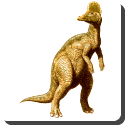 Corythosaurus — Corythosaurus meaning ’helmet lizard’ because of the shape of its crest (Greek korythos meaning ’helmet’ and sauros meaning ’lizard’) was a genus of duck-billed dinosaur from the Upper Cretaceous Period, about 80 million years ago. It lived in what is now North America.
Corythosaurus — Corythosaurus meaning ’helmet lizard’ because of the shape of its crest (Greek korythos meaning ’helmet’ and sauros meaning ’lizard’) was a genus of duck-billed dinosaur from the Upper Cretaceous Period, about 80 million years ago. It lived in what is now North America.
The first specimen was discovered in 1912 by Barnum Brown in Red Deer River, Alberta, Canada . As well as an almost complete skeleton, the find was remarkable because much of the creature’s fossilised skin had also survived. In 1916, the Canadian (Canadian Pacific Lines) ship Mount Temple was carrying two specimens and other fossils from today’s Dinosaur Provincial Park, Alberta, Canada to Britain. It was sunk by the German surface raider SMS Moewe, sending its 75 million year old cargo to the bottom of the North Atlantic, where it rests to this day.
There were originally up to 7 species described including C. casaurius, C. bicristatus, C. brevicristatus, C. excavatus, C. frontalis, and C. intermedius. In 1975 Peter Dodson studied the differences between the skulls and crests of different species of lambeosaurine dinosaurs. He found that the differences in size and shape may have actually been related to the gender and age of the animal. Now only one species is recognised, C. casuarius.
Corythosaurus weighed in at 4 tonnes and measured roughly 10 metres (35 ft) from nose to tail. Like other hadrosaurs it had a toothless beak, the back of the jaws contained a dental battery composed of hundreds of small, interlocking teeth. These were used to crush and grind plant matter and were continually replaced as they wore away.
Over 20 skulls have been found from this dinosaur. As with other lambeosaurs, the animal bore a tall, elaborate bony crest atop its skull, which contained the elongate nasal passages. The nasal passages extended into the frill and probably allowed it to act as a sounding device.
It was once thought that this dinosaur lived mostly in the water, due to the appearance of webbed hands and feet. However, it was later discovered that the so-called “webs” were in fact deflated padding, much like that found on many modern mammals.
 Kids Portal For Parents India Kids Network
Kids Portal For Parents India Kids Network
